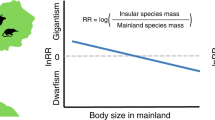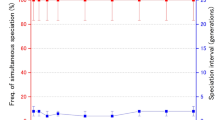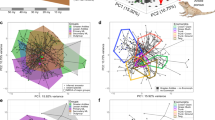Abstract
SMALL islands have fewer species than larger islands or mainlands, and the number of species of very large predators, for example raptorial birds, may be disproportionately lower1,2. This suggests the reasonable but largely untested idea that predation is less important as a determinant of population structure on small islands than on large islands or mainlands, particularly for relatively large potential prey such as songbirds and lizards3–10. We have compared the survival of three species of the lizard Anolis on two islands differing in size and number of predatory bird species. We report here that annual survival in sites identical in diurnal lizard species and nearly so in vegetation structure is smaller, and usually substantially so, on the larger island. In one species, the size distribution of males parallels this difference in survival: lizards are smaller where survival is lower. Sexual differences in survival between the two islands are especially marked in an intensely territorial, polygamous species.
This is a preview of subscription content, access via your institution
Access options
Subscribe to this journal
Receive 51 print issues and online access
$199.00 per year
only $3.90 per issue
Buy this article
- Purchase on SpringerLink
- Instant access to full article PDF
Prices may be subject to local taxes which are calculated during checkout
Similar content being viewed by others
References
Lack, D. Darwin's Finches (Cambridge University Press, 1947).
Diamond, J. M. in Ecology and Evolution of Communities (eds Cody, M. L. & Diamond, J. M.) 342–444 (Harvard University Press, Cambridge, 1975).
Carlquist, S. Island Life (Natural History Press, New York, 1965); Island Biology (Columbia University Press, New York, 1974).
Kramer, G. Z. Naturforsch. 1, 700–710 (1946).
Cody, M. L. Evolution 20, 174–184 (1966).
Rand, A. S. & Humphrey, S. S. Proc. U. S. natn. Mus. 125, 1–17 (1968).
Rand, A. S. & Williams, E. E. Breviora Mus. Comp. Zool. 327, 1–19 (1969).
Andrews, R. M. thesis, Harvard Univ. (1971); Copeia 1976, 477–482 (1976).
Schoener, T. W. Am. Nat. 104, 155–174 (1970); in Biology of the Reptilia (eds Gans, C. & Tinkle, D. W.) 35–136 (Academic, London, 1977).
Lister, B. C. Evolution 30, 659–676 (1976).
Paulson, D. Notulae Naturae 394, 1–15 (1966).
Vaurie, C. Auk 70, 38–48 (1953).
McNab, B. Am. Nat. 97, 133–139 (1963).
Schoener, T. W. Ecology 49, 123–141 (1968).
Turner, F. B., Jennrich, R. I. & Weintraub, J. D. Ecology 50, 1076–1081 (1969).
Schwartz, A. & Thomas, R. A Check-list of West Indian Amphibians and Reptiles (Carnegie Museum, Pittsburgh, 1975).
Schoener, T. W. & Schoener, A. Copeia (in the press 1978).
Schoener, T. W. Am. Natur. 103, 277–313 (1969); Science 185, 27–38 (1975); Proc. natn. Acad. Sci. U.S.A. 71, 4169–4172 (1974).
Ruibal, R. & Philibosian, R. Ecology 55, 525–537 (1974).
Philibosian, R. Copeia 1975, 428–444 (1975).
Schoener, T. W. Theor. Pop. Biol. 6, 265–307 (1974); Ecol. Monogr. 45, 233–252 (1975).
Howard, R. A. Ecol. Monogr. 20, 318–349 (1950).
Jennrich, R. I. & Turner, F. B. J. theoret. Biol. 22, 227–237 (1969).
Author information
Authors and Affiliations
Rights and permissions
About this article
Cite this article
SCHOENER, T., SCHOENER, A. Inverse relation of survival of lizards with island size and avifaunal richness. Nature 274, 685–687 (1978). https://doi.org/10.1038/274685a0
Received:
Accepted:
Issue date:
DOI: https://doi.org/10.1038/274685a0
This article is cited by
-
Competition, predation and natural selection in island lizards
Nature (2011)
-
Variation in scale numbers is consistent with ecologically based natural selection acting within and between lizard species
Evolutionary Ecology (2006)
-
Density effects on life‐history traits of an island lizard population
Ecological Research (1997)
-
Demography of an island population of the lizard, Eumeces okadae, on Miyake‐jima, Izu Islands
Population Ecology (1990)
-
Effects of habitat and season on competitive interactions between roach (Rutilus rutilus) and perch (Perca fluviatilis)
Oecologia (1987)



